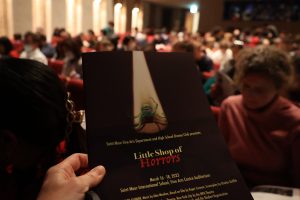Sophie Wynkoop
The original 1960 production of Little Shop of Horrors (directed by Howard Ashman) was indelible for its quirky, unusual and playful nature. With its elements of horror, satire, and science fiction, the play succeeded in shocking its viewers with its inclusion of social commentary and alien vegetation in one storyline. In the Saint Maur International school adaptation of Little Shop of Horrors, none of the charm or delight of the original was lost. With its excellent and well-casted set of actors and actresses, the overall performance proved to be hilarious and bizarre. The play had a lasting impression that will not be forgotten as it goes down in Saint Maur’s rich history.
The prologue opens with Ronette (Mairi (G9)), Crystal (Claire (G9)), and Chiffon (Yuxin (G9)) performing a musical introduction to the play. I found the song, “Little Shop Of Horrors”, to be a particularly melodic piece. As it was the viewer’s first impression of the play, the repetition of the title “Little Shop of Horrors” in the chorus of the song served to be both satisfying and delightful. Due to all three of the actress’s exceptional vocals, the song was enhanced in both its appeal and memorability. In general, the performance of the soundtrack of this play was one of its most redeeming qualities.
Seymour (Kole (G12)) and his colleagues, Audrey (Jessica (G12) and Rei (G11)), work at Mushnik’s Flower Shop in Skid Row, New York City. Skid Row is recognized for being an especially impoverished area of New York City. The play gives no disregard to this, even going so far as to having a whole musical number dedicated to expressing the low socioeconomic statuses of the residents of the neighborhood. This factor is very meaningful to the storyline, as it drives Seymour to continue to feed and nurture Audrey II in hopes of increasing the profits of his flower shop. Audrey is also very driven by this desperate desire to escape her penurious life. So much so that she was committed to staying with her heavily abusive partner because of his high paying profession. These themes of poverty can be perceived as a subtle yet strong commentary on social hierarchy. Saint Maur students and faculty who came to view this play were able to see characters who have known impoverishment since childhood and reflect back on the wonderful education they receive at Saint Maur. Scarcity as a theme can be taken as a symbol that reminds us of the privilege we yield by experiencing quality education. The play did a splendid job of presenting this theme in a tenuous yet explicit fashion.
Another aspect of the play that is worth noting are the props and set. Audrey II, the carnivorous plant, was especially well-executed. There were three puppets used in the play, each increasing in size as Audrey II consumed more amounts of human blood. The biggest puppet was by far the most impressive. Operated by Hinata (G9) and Keiichiro (G12), the plant moved as realistically as one would imagine a magical plant would move. The costumes were also very impressive and accurate to the setting. One aspect that I noticed were the cobwebs being removed after Mushnik’s flower shop started gaining more wealth. It was a small detail, but one that the play did with much mindfulness.
It’s apparent that though the Saint Maur drama club chose a difficult play to perform, the team carried out the play without fault. From the casting to the music, Little Shop of Horrors was a play that will be remembered for its entertainment qualities and its themes of poverty, hopelessness, and self-sacrifice. I extend my deepest congratulations to directors, actors, and crew for yet another successful Saint Maur production!

Sophie Wynkoop




